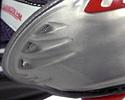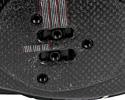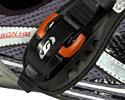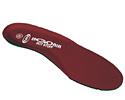
Recently on Cyclingnews.com |
On test: Louis Garneau Carbon Air Shoes, May 30, 2006
A shoe for all seasons
Louis Garneau's Carbon Air shoes have an extensive ventilation system and interchangeable insoles to help make these shoes comfortable in the heat and cold, as John Kenny found.
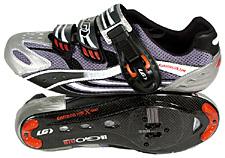
|
Louis Garneau, ex-LA Olympian and Canadian individual pursuit champion, established his cycling clothing and parts company in 1983. His company manufactures a range of gear for cyclists, such as helmets, custom clothing and frames. The company's involvement in cycling extends to team sponsorship, most notably providing helmets for the Bouyges Telecom ProTour team.
Louis Garneau's Carbon Air shoes have all of the features that are normally demanded of a top-quality shoe: light weight (around 600 grams for a pair of size 42s), a three-strap system (one with a ratchet, two with Velcro), a stiff carbon sole and compatibility with all the major pedal manufacturers. The hook for buyers could be the superior ventilation on offer and two sets of insoles to cover the seasonal variations in temperature.
Attributes
The shoe uppers are ventilated via a combination of perforated leather and nylon mesh. The vents extend to the heel cup (to release the heat that builds up around the back of the shoe) and, unusually, to a set of vents along the carbon sole. When the shoes are worn in conjunction with the blue ventilated insoles, they keep your feet very cool. I took delivery of the shoes long after the peak of summer had passed and I quickly swapped the insoles for the non-ventilated red options for a bit of extra warmth.
|
|
|
|
|
|
|
|
|
|
|
|
|
The ventilation seemed to work extremely efficiently, as my socks felt dry after each ride. More importantly, my feet felt comfortable, even on cool mornings. A dry foot is normally a warm foot. The shoes also dried very quickly after being soaked through and did not pick up the lingering damp smell that is generally part of the whole experience.
The silver, grey and black appearance is also very appealing to my conservative palate - classy and stylish enough to do justice to the French-sounding name. The rather blocky square toe may well be fashionable, but that's a call beyond my area of expertise.
The fit
The size 45 shoes tested were considerably snugger than my regular shoes. It's normal to get a bit of variation between manufacturers in sizing. Louis Garneau provides enough size variations to suit most adult feet. There are 14 sizes between 40 and 48 with half-centimetre jumps between common sizes (42 to 46). It's worth noting that my test shoes stretched a little and after two weeks they fitted comfortably.
Ratchet system
The two red release levers on each shoe are intended to allow fine adjustment of pressure across the top of the foot, as the back of each lever hooks independently onto the strap notches, providing double the tightening increments. However, there is a downside to the system. It's fiddly for starters. I needed to use my index finger and thumb on one hand to depress the levers and my other hand to pull on the strap.
I would hardly have noticed the finicky ratchet if it was reliable, but the shoes could be extremely difficult to remove when the release mechanism failed to liberate the strap.
The first time that I could not get the ratchet to release the strap, I fought with the shoe for 15 minutes before I dragooned some of my post-race colleagues to render assistance. A screwdriver was produced and there was a suggestion (only half-joking) that a Stanley knife should be found to cut the strap. The whole experience put a bit of a strain on my dignity, as I had removed all my other cycling clothes and all that was protecting my modesty was a strategically placed cycling jersey.
The problem affected both shoes, so I couldn't really put it down to a manufacturing anomaly.
I developed a technique that involved using my middle finger to put pressure on the strap while other digits depressed the ironically named quick-release mechanism. It was all a little tiresome after a long ride or race.
Overall
The soles of the Carbon Airs are extremely stiff and permit maximum power transfer. Fantastic ventilation kept my feet dry and comfortable. Once I got the fore-aft and lateral adjustments right and the uppers stretched a little, the shoes felt extremely comfortable. The obstinate ratchet soured my experience somewhat, but this was something that was annoying rather than crucial and the failure to release was occasional.
Weight: 710 grams (size 45 as tested); 586 grams (size 42 claimed)
Price: About US$200
Pros: Styling, ventilation, light and stiff
Cons: The ratchet sometimes failed to release the main strap
Cyclingnews rating: ![]()
More information: www.louisgarneau.com
Photography
For a thumbnail gallery of these images, click here
Images by John Stevenson/Cyclingnews
- Louis Garneau Carbon Air shoes - stiff-soled high-end footwear with seasonal adaptability
- Under-foot ventilation is provided by these mesh-covered vents in the sole
- The mesh upper and perforated leather reinforcement keeps your feet comfortable.
- The heel cup is ventilated and reflective for night-time safety.
- More ventilation - plus an anti-slip pad under the toe for that stroll from your bike to the cafe table.
- Look and SPD compatibility - the Carbon Air is one of few shoes to offer more than a three-bolt cleat fixing.
- A pull-loop helps get the tongue out of the way when you pull on the shoe.
- The ratchet buckle provides finer than usual adjustment of the tension across the top of your foot, but at the price of being a bit fiddly to release.
- The summer insole is ventilated to help keep your feet cool.
- The winter insole lacks holes so that the ventilation is less effective at the time of year when it's less needed.


